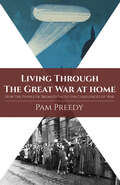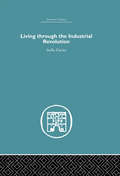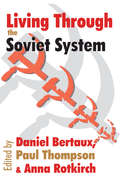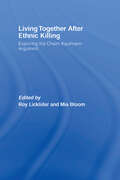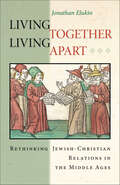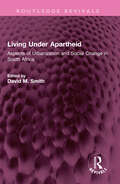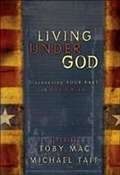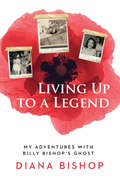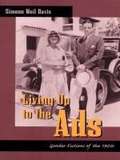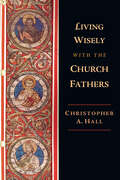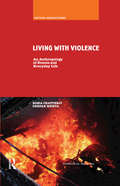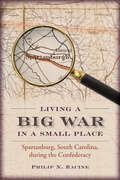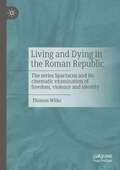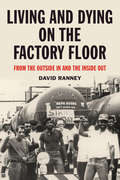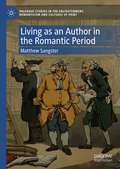- Table View
- List View
Living Through Perestroika: The Soviet Union in Upheaval, 1985-1991 (Bedford Document Collection )
by Robert W. StrayerThis document collection will help students make connections between individuals' responses to the demise of Soviet communism and their economic, political, and social position within Soviet society during the Gorbachev era (1985-1991). Students are guided through their analysis of the primary sources with an author-provided learning objective, central question, and historical context.
Living Through The Great War at Home: How the People of Bromley Faced the Challenges of War
by Pam PreedyLiving Through the Great War at Home tells the story of the people of Bromley from the month before the outbreak of war to the Armistice in 1918 and the celebration of peace in July 1919. Although it shows how men were mobilised, volunteered, conscripted and left to ‘follow the colours’, it is a book about the people of Bromley and how their lives were challenged and changed during the war, how they supported their own boys in the army, how they dealt with the problems of war, the restrictions of DORA (Defence of the Realm Act) and the threat and reality of the Zeppelin raids. We learn of the generosity of the people in supporting their ‘boys’, caring for the Belgian refugees and the wounded—the VAD hospitals and how women rose to the challenge, both in terms of filling the gaps in the workforce left by the men and struggling to put food on the table as rising prices and shortages finally led to rationing. The work is based on real information from the local newspaper, together with research to put them into context and understand the stories better.
Living Through the Industrial Revolution
by Stella DaviesFirst published in 1966, this revealing study looks closely into the lives of the men, women and children working in mines, workshops, factories and farms during the industrial revolution. It investigates the inventors whose new machines made the industrial revolution possible, and reflects on the new type of employer whose enterprise and energy in linking machine and labour power formed a new society. Where possible, contemporary accounts, letters, diaries and reports have been used so that the words of those living through this remarkable time can be heard - the words and thoughts of masters, workpeople, apprentice children, 'improving landlords' and farm labourers illuminate the prevailing attitudes of the period. An introductory chapter outlines previous methods of living and working and shows the first movements towards the industrial revolution. Describing successes and failures, lives of impoverishment and hardship, fortunes made and, sometimes, lost, and the effects of the new society, this enlightening study investigates how early struggles to cope with almost overwhelming problems are now seen as the beginnings of the comparatively comfortable conditions we benefit from today.
Living Through the Industrial Revolution
by Stella DaviesFirst published in 1966, this revealing study looks closely into the lives of the men, women and children working in mines, workshops, factories and farms during the industrial revolution. It investigates the inventors whose new machines made the industrial revolution possible, and reflects on the new type of employer whose enterprise and energy in linking machine and labour power formed a new society. Where possible, contemporary accounts, letters, diaries and reports have been used so that the words of those living through this remarkable time can be heard - the words and thoughts of masters, workpeople, apprentice children, 'improving landlords' and farm labourers illuminate the prevailing attitudes of the period. An introductory chapter outlines previous methods of living and working and shows the first movements towards the industrial revolution. Describing successes and failures, lives of impoverishment and hardship, fortunes made and, sometimes, lost, and the effects of the new society, this enlightening study investigates how early struggles to cope with almost overwhelming problems are now seen as the beginnings of the comparatively comfortable conditions we benefit from today.
Living Through the Soviet System (Memory And Narrative Ser.)
by Leo LowenthalFor a period of over seventy years after the 1917 revolutions in Russia, talking about the past, either political or personal, became dangerous. The situation changed dramatically with the new policy of glasnost at the end of the 1980s. The result was a flood of reminiscence, almost nightly on television, and more formally collected by new Russian oral history groups and also by Western researchers. Daniel Bertaux and Paul Thompson both began collecting life story and family history interview material in the early 1990s, and this book is the outcome of their initiative. Living Through the Soviet System analyzes, through personal accounts, how Russian society operated on a day-to-day level. It contrasts the integration of different social groups: the descendents of the pre-revolutionary upper classes, the new industrial working class, or the ethnically marginalized Russian Jews. It examines in turn the implications of family relationships, working mothers, absent fathers and caretaking grandmothers; patterns of eating together, and of housing; the secrecy of sex; the suppression of religion; and the small freedoms of growing vegetables on weekends on a dacha plot. Because of its basis in direct testimonies, the book reveals in a highly readable and direct style the meaning for ordinary men and women of living through those seven dark decades of a great European nation. Because of the centrality of Soviet Russia to the history of the twentieth-century world, this book will be of interest to a wide range of readers. It will be of importance to students, researchers and teachers of history and sociology, as well as specialists in East European and other communist societies.
Living Together
by Carole MortimerRe-read this classic romance by USA Today bestselling author CaroleMortimerSuccessful actor Leon Masters is completely entranced when he meets beautiful, shyHelen West and is shocked when she rebuffs his advances. He can see the desire in her eyesyet she's so emotionally shut off…Living together soon opens Leon's eyes to Helen's fear about men. What could havepossibly happened to make this lovely creature so terrified of intimacy? Leon doesn'tknow, but he's determined to show Helen that if there's only one man she can trust, it'shim… Originally published in 1980
Living Together After Ethnic Killing: Exploring the Chaim Kaufman Argument
by Mia Bloom Roy LickliderThis volume attempts to critically analyze Chaim Kaufman's ideas from various methodological perspectives, with the view of further understanding how stable states may arise after violent ethnic conflict and to generate important debate in the area. After the Cold War, the West became optimistic of their ability to intervene effectively in instances of humanitarian disasters and civil war. Unfortunately, in the light of Bosnia, Somalia and Rwanda, questions of the appropriate course of action in situations of large scale violence became hotly contested. A wave of analysis considered the traditional approach of third parties attempting to ensure that the nation was built on the basis of a ruling power-share between the opposing sides of the conflict to be overwhelmingly problematic, and perhaps impossible. Within this movement Kaufman wrote a series of articles advocating separation of warring sides in order to provide stability in situations of large scale violence. His theorem provoked extreme responses and polarized opinion, contradicting the established position of promoting power-sharing, democracy and open economies to solve ethnic conflict and had policy implications for the entire international community. This book was previously published as a special issue of Security Studies.
Living Together, Living Apart: Rethinking Jewish-Christian Relations in the Middle Ages (Jews, Christians, and Muslims from the Ancient to the Modern World #53)
by Jonathan ElukinThis book challenges the standard conception of the Middle Ages as a time of persecution for Jews. Jonathan Elukin traces the experience of Jews in Europe from late antiquity through the Renaissance and Reformation, revealing how the pluralism of medieval society allowed Jews to feel part of their local communities despite recurrent expressions of hatred against them. Elukin shows that Jews and Christians coexisted more or less peacefully for much of the Middle Ages, and that the violence directed at Jews was largely isolated and did not undermine their participation in the daily rhythms of European society. The extraordinary picture that emerges is one of Jews living comfortably among their Christian neighbors, working with Christians, and occasionally cultivating lasting friendships even as Christian culture often demonized Jews. As Elukin makes clear, the expulsions of Jews from England, France, Spain, and elsewhere were not the inevitable culmination of persecution, but arose from the religious and political expediencies of particular rulers. He demonstrates that the history of successful Jewish-Christian interaction in the Middle Ages in fact laid the social foundations that gave rise to the Jewish communities of modern Europe. Elukin compels us to rethink our assumptions about this fascinating period in history, offering us a new lens through which to appreciate the rich complexities of the Jewish experience in medieval Christendom.
Living Treasure: Buddhist and Tibetan Studies in Honor of Janet Gyatso (Studies in Indian and Tibetan Buddhism)
by Holly Gayley and Andrew QuintmanSenior scholars and former students celebrate the life and work of Janet Gyatso, professor of Buddhist studies at Harvard Divinity School. Inspired by her contributions to life writing, Tibetan medicine, gender studies, and more, these offerings make a rich feast for readers interested in Tibetan and Buddhist studies.Janet Gyatso has made substantial, influential, and incredibly valuable contributions to the fields of Buddhist and Tibetan studies. Her paradigm-shifting approach is to take a topic, an idea, a text, a term—often one that had long been taken for granted or overlooked—and turn it inside out, to radically reimagine the kinds of questions that might be asked and what the answers might reveal. The twenty-nine essays in this volume, authored by colleagues and former students—many of whom are now also colleagues—represent the breadth of her interests and influence and the care that she has taken in training the current generation of scholars of Tibet and Buddhism. They are organized into five sections: Women, Gender, and Sexuality; Biography and Autobiography; the Nyingma Imaginaire; Literature, Art, and Poetry; and Early Modernity: Human and Nonhuman Worlds. Contributions include José Cabezón on the incorporation of a Buddhist rock carving in Central Asian culture; Matthew Kapstein on the memoirs of an ambivalent reincarnated lama; Willa Baker on Jikmé Lingpa&’s theory of absence; Andrew Quintman on a found poem expressing worldly sadness on the forced closure of a monastery; and Padma &’tsho on Tibetan women&’s advocacy for full female ordination. These and the many other chapters, each fascinating reads in their own right, together offer a glowing tribute to a scholar who indelibly changed the way we think about Buddhism, its history, and its literature.
Living Under Apartheid: Aspects of Urbanization and Social Change in South Africa (Routledge Revivals)
by David M. SmithOriginally published in 1982, this book covers the unique spatial structure of society which was South Africa under apartheid. It brings together a cohesive set of research-based contributions to the understanding of this system which was without contemporary parallels. The book considers issues such as industrial location and migrant labour at a national scale. The case studies, which are fully illustrated, deal with problems associated with work and housing for blacks, set in the 3 major metropolitan areas of Cape Town, the Witwatersrand and Durban. Of particular importance is the emphasis given to so-called ‘spontaneous’ (or ‘squatter’) settlement and to informal-sector work for blacks in the emerging apartheid city – something which links directly with central issues of development studies.
Living Under God: Discovering Your Part In God's Plan
by Michael Tait Toby MacBuilding from the stories in Under God, each of the 60 four-page readings opens with Scripture and then presents a theme, including justice, mercy, and sacrifice, among other, illustrated in the lives and events of our country's past. <P><P> Excerpts from Under God are married with deeper biblical exploration of these virtues, followed by tips on how they can be put into action in young people's lives today. <P><P>Questions for further study and discussion starters facilitate the use of Living Under God in group settings.
Living Up to a Legend: My Adventures with Billy Bishop's Ghost
by Diana BishopDiana Bishop recounts growing up in the shadow of her famous grandfather, Canadian First World War flying ace Billy Bishop. As a child, Diana Bishop showed up one day at school with a brown paper bag. Inside was a large breastplate of some of the most precious war medals on the planet, including the Victoria Cross. They belonged to Canada’s most celebrated First World War pilot, Billy Bishop, and until her family donated them to the Canadian War Museum, they had been kept in her father’s underwear drawer. That day at school was the first time Diana realized she was not growing up in an ordinary family. Now, after more than two decades in Canadian media, Diana Bishop looks back on her grandfather’s legacy and its profound influence over her life, and also her father’s — the only son of Billy Bishop, who had so much to live up to. Living Up to a Legend is a unique memoir that covers Billy Bishop’s legacy through the eyes of one of the people who it affected the most.
Living Up to the Ads: Gender Fictions of the 1920s
by Simone Weil DavisIn Living Up to the Ads Simone Weil Davis examines commodity culture's impact on popular notions of gender and identity during the 1920s. Arguing that the newly ascendant advertising industry introduced three new metaphors for personhood--the ad man, the female consumer, and the often female advertising model or spokesperson--Davis traces the emergence of the pervasive gendering of American consumerism. Materials from advertising firms--including memos, manuals, meeting minutes, and newsletters--are considered alongside the fiction of Sinclair Lewis, Nella Larsen, Bruce Barton, F. Scott Fitzgerald, and Zelda Fitzgerald. Davis engages such books as Babbitt, Quicksand, and Save Me the Waltz in original and imaginative ways, asking each to participate in her discussion of commodity culture, gender, and identity. To illuminate the subjective, day-to-day experiences of 1920s consumerism in the United States, Davis juxtaposes print ads and industry manuals with works of fiction. Capturing the maverick voices of some of the decade's most influential advertisers and writers, Davis reveals the lines that were drawn between truths and lies, seduction and selling, white and black, and men and women. Davis's methodology challenges disciplinary borders by employing historical, sociological, and literary practices to discuss the enduring links between commodity culture, gender, and identity construction. Living Up to the Ads will appeal to students and scholars of advertising, American studies, women's studies, cultural studies, and early-twentieth-century American history.
Living Well with Pessimism in Nineteenth-Century France (Palgrave Studies in Nineteenth-Century Writing and Culture)
by Joseph AcquistoThis book traces the emergence of modern pessimism in nineteenth-century France and examines its aesthetic, epistemological, ethical, and political implications. It explores how, since pessimism as a worldview is not empirically verifiable, writers on pessimism shift the discussion to verisimilitude, opening up rich territory for cross-fertilization between philosophy and literature. The book traces debates on pessimism in the nineteenth century among French nonfiction writers who either lauded its promotion of compassion or condemned it for being a sick and unliveable attempt at renunciation. It then examines the way novelists and poets take up and transform these questions by portraying characters in lived situations that serve as testing grounds for the merits or limitations of pessimism. The debate on pessimism that emerged in the nineteenth century is still very much with us, and this book offers an interhistorical argument for embracing pessimism as a way of living well in the world, aesthetically, ethically, and politically.
Living When Everything Changed: My Life in Academia
by Mary Kay TetreaultEntering the academy at the dawn of the women’s rights movement in the late 1960s and early 1970s, the first generation of feminist academics had a difficult journey. With few female role models, they had to forge their own path and prove that feminist scholarship was a legitimate enterprise. Later, when many of these scholars moved into administrative positions, hoping to reform the university system from within, they encountered entrenched hierarchies, bureaucracies, and old boys’ networks that made it difficult to put their feminist principles into practice. In this compelling memoir, Mary Kay Thompson Tetreault describes how a Catholic girl from small-town Nebraska discovered her callings as a feminist, as an academic, and as a university administrator. She recounts her experiences at three very different schools: the small progressive Lewis & Clark College, the massive regional university of Cal State Fullerton, and the rapidly expanding Portland State University. Reflecting on both her accomplishments and challenges, she considers just how much second-wave feminism has transformed academia and how much reform is still needed. With remarkable candor and compassion, Thompson Tetreault provides an intimate personal look at an era when both women’s lives and university culture changed for good. The Acknowledgments were inadvertently left out of the first printing of this book. We apologize for the oversight, and offer them here instead. Future printings will include this information. (https://d3tto5i5w9ogdd.cloudfront.net/wp-content/uploads/2019/08/29185420/Thompson-Tetreault-Acknowledgments.pdf)
Living Wisely with the Church Fathers
by Christopher A. HallThe first centuries of Christianity are like a far country. But despite their foreignness, they hold a treasury of wisdom for living. Early Christians struggled and flourished in a culture that was in love with empire and military power, infatuated with sex and entertainment, tolerant of all gods but hostile to the One. And from this crucible of discipleship they extracted lessons of virtue, faithfulness, and joy in Christ. Christopher Hall takes us to this distant time, where he interviews Christian leaders around the ancient Mediterranean world, inquiring how to live a good life as a Christ follower. The menu of topics wends its way through wealth and poverty, war and violence, marriage and sexuality, theater and the arena, as well as the harsh realities of persecution and martyrdom. Gathering around Basil or Chrysostom or Augustine, we are instructed anew in the way of discipleship. And as they grapple with issues surprisingly resonant with our own, this cloud of ancient witnesses both surprises and challenges us in the life of faith.
Living With Violence: An Anthropology of Events and Everyday Life (Critical Asian Studies)
by Roma Chatterji Deepak MehtaThis book gives a detailed account of the ‘communal riots’ between Hindus and Muslims in Mumbai in 1992-93. It departs from the historiography of the riot, which assumes that Hindu-Muslim conflict is independent of the participants of the violence.Speaking to and interacting with the residents of Dharavi, the largest shanty town in the city, the authors collected a wide range of narrative accounts of the violence and the procedures of rehabilitation that accompanied the violence. The authors juxtapose these narrative accounts with public documents exploring the role language, work, housing and rehabilitation have on the day-to-day life of people who live with violence.
Living Worth: Value and Values in Global Pharmaceutical Markets (Critical Global Health: Evidence, Efficacy, Ethnography)
by Stefan EcksIn Living Worth Stefan Ecks draws on ethnographic research on depression and antidepressant usage in India to develop a new theory of value. Framing depressive disorder as a problem of value, Ecks traces the myriad ways antidepressants come to have value, from their ability to help make one’s life worth living to the wealth they generate in the multibillion-dollar global pharmaceutical market. Through case studies that include analyses of the different valuation of generic and brand-name drugs, the origins of rising worldwide depression rates, and the marketing, prescription, and circulation of antidepressants, Ecks theorizes value as a process of biocommensuration. Biocommensurations—transactions that aim or claim to make life better—are those forms of social, medical, and corporate actions that allow value to be measured, exchanged, substituted, and redistributed. Ecks’s theory expands value beyond both a Marxist labor theory of value and a free market subjective theory, thereby offering new insights into how the value of lives and things become entangled under neoliberal capitalism.
Living Zen [Second Edition]
by Robert LinssenLiving Zen is that rare achievement, both a survey of the rich history of Zen Buddhism and a guide to the practice of this most demanding and effortless art of being. The distinguished Belgian scholar Robert Linssen offers a sage corrective to the idea that the Zen way is available only to those prepared to sit life out under the Bodhi-Tree. Gently but insistently he undermines this typically Western view; inviting and enabling us, as Christmas Humphreys puts it in his preface, to take "the leap from thought to No-thought, from the ultimate duality of Illusion/Reality to a burst of laughter and a cup of tea.""Linssen's aim throughout this penetrating book is to encourage his readers to outgrow the cocoon of self-centered thought and feeling. The core of the book lies in its lucid analysis...and in the meaning which it gives to the true attention, focused undesirously in the immediate present, which can dissolve the endless distractions of the fear-conditioned ego."--The Times Literary Supplement"Robert Linssen finally gives a sensible explanation of what Zen is all about."--Saturday Review"An excellent study."--San Francisco Chronicle
Living a Big War in a Small Place: Spartanburg, South Carolina, during the Confederacy
by Philip N. RacineA history of life in one South Carolina city during the American Civil War, featuring personal stories from those who were there.Most of what we know about how the Civil War affected life in the Confederacy is related to cities, troop movements, battles, and prominent political, economic, or military leaders. Far less is known about the people who lived in small Southern towns remote from marching armies or battles. Philip N. Racine explores life in one such place—Spartanburg, South Carolina—in an effort to reshape the contours of that great conflict.By 1864 life in most of the Confederacy, but especially in rural towns, was characterized by scarcity, high prices, uncertainty, fear, and bad-tempered neighbors. Shortages of food were common. People lived with constant anxiety that a soldiering father or son would be killed or wounded. Taxes were high, inflation was rampant, good news was scarce and seemed to always be followed by bad. The slave population was growing restive as their masters’ bad news was their good news. Army deserters were threatening lawlessness; accusations and vindictiveness colored the atmosphere and added to the anxiety, fear, and feeling of helplessness. Often people blamed their troubles on the Confederate government in faraway Richmond, Virginia.Racine provides insight into these events through personal stories: the plight of a slave; the struggles of a war widow managing her husband’s farm, ten slaves, and seven children; and the trauma of a lowcountry refugee’s having to forfeit a wealthy, aristocratic way of life and being thrust into relative poverty and an alien social world. All were part of the complexity of wartime Spartanburg District.“A well-written account that not only captures the plight of both the black and white population, but also offers some amazing cameos, especially the life of Emily Lyle Harris, who struggled to keep her large family in tact while her husband went off to war. This is a lively read and a perfect book to assign for classes covering the Carolina Upstate during the American Civil War.” —Edmund L. Drago, professor of history, The College of Charleston, and author of Confederate Phoenix: Rebel Children and Their Families in South Carolina“Living a Big War offers a fascinating, unflinching look at the toll the Civil War took on Spartanburg, clearly showing divisions that emerged and deftly employing stories of slaves, women, and other individuals to reveal the experiences of people on the home front.” —Gaines M. Foster, dean, College of Humanities and Social Sciences, Louisiana State University, and author of Ghosts of the Confederacy: Defeat, the Lost Cause and the Emergence of the New South, 1865–1913
Living a Lie: An utterly captivating saga of the power of true love
by Josephine CoxIs Kitty Marsh living a lie when she tries to keep her first love in the past? In Living a Lie, Josephine Cox weaves a heart-wrenching saga of a young woman leaving behind more than she bargained for. Perfect for fans of Kitty Neale and Dilly Court.In 1975 Lucinda Marsh throws herself in front of a speeding train leaving her twelve-year-old daughter Kitty alone, confused and abandoned - save for a selfish aunt, a violent father and her childhood sweetheart Harry Jenkins.When Kitty is sent to an orphanage after the death of her father, she meets Georgie, a lively cockney girl who, through the following difficult years, becomes her loyal friend. Convinced that her feelings for Harry will ruin the brilliant future that lies ahead of him, Kitty turns her back on his love. Together with Georgie, she strives to find fulfilment in other places and other relationships, but when fate throws her back together with Harry she begins to wonder if true love can ever die...What readers are saying about Living a Lie: 'This is a delightful story of friendship through thick and thin. There is plenty of heartache but also true romance... I personally consider this to be [Josephine Cox's] most well thought out and lovingly created masterpiece''The author drew me in to the plot from the first sentence...In this book you will find themes of coming of age, romance and strength through adversity''Couldn't put this book down. Emotional ups and downs and totally addictive'
Living a Lie: An utterly captivating saga of the power of true love
by Josephine CoxIs Kitty Marsh living a lie when she tries to keep her first love in the past? In Living a Lie, Josephine Cox weaves a heart-wrenching saga of a young woman leaving behind more than she bargained for. Perfect for fans of Kitty Neale and Dilly Court.In 1975 Lucinda Marsh throws herself in front of a speeding train leaving her twelve-year-old daughter Kitty alone, confused and abandoned - save for a selfish aunt, a violent father and her childhood sweetheart Harry Jenkins.When Kitty is sent to an orphanage after the death of her father, she meets Georgie, a lively cockney girl who, through the following difficult years, becomes her loyal friend. Convinced that her feelings for Harry will ruin the brilliant future that lies ahead of him, Kitty turns her back on his love. Together with Georgie, she strives to find fulfilment in other places and other relationships, but when fate throws her back together with Harry she begins to wonder if true love can ever die... What readers are saying about Living a Lie: 'This is a delightful story of friendship through thick and thin. There is plenty of heartache but also true romance... I personally consider this to be [Josephine Cox's] most well thought out and lovingly created masterpiece''The author drew me in to the plot from the first sentence...In this book you will find themes of coming of age, romance and strength through adversity''Couldn't put this book down. Emotional ups and downs and totally addictive'
Living and Dying in the Roman Republic: The Series Spartacus and its Cinematic Examination of Freedom, Violence and Identity
by Thomas WilkeThis volume deals with the American production "Spartacus" and the British-American-Italian co-production Rome. In the examination of the present, a turn to Greek or Roman antiquity can be observed again and again. To find there the roots of Western society for politics, economics or philosophy, or to derive comparative arguments for expansionist efforts or decline, is not just part of the rhetorical commonplace. So it is not surprising that the TV series format also takes up this period. Whereas in Rome the attempt is made to work through the historical guidelines in great detail, in Spartacus, apart from the rough sketch of the plot, one can speak of a far-reaching neglect of the historical situation. From a (media) ethical perspective, specific approaches to responsibility, the transmission of values, loyalty, education, self-discipline, and religion can be identified in the series, which can be interpreted as self-statements of the present or the producers.
Living and Dying on the Factory Floor: From the Outside In and the Inside Out
by David RanneyDavid Ranney’s vivid memoir describes his work experiences between 1976 and 1982 in the factories of southeast Chicago and northwest Indiana, one of the heaviest industrial concentrations in the world. The author takes the reader on a walk through the heart of Chicago’s South Side, observing the noise, heavy traffic, the 24-hour restaurants and bars, the rich diversity of people on the streets at all hours of the day and night, and the smell of the highly polluted air. Factory life includes stints at a machine shop, a shortening factory, a railroad car factory, a structural steel shop, a box factory, a chemical plant, and a paper cup factory. Along the way there is a wildcat strike, an immigration raid, shop-floor actions protesting supervisor abuses, serious injuries, a failed effort to unionize, and a murder. Ranney’s emphasis is on race and class relations, working conditions, environmental issues, and broader social issues in the 1970s that impacted the shop floor. Forty years later, the narrator returns to Chicago’s South Side to reveal what happened to the communities, buildings, and the companies that had inhabited them. Living and Dying on the Factory Floor concludes with discussions on the nature of work; racism, race, and class; the use of immigration policy for social control; and our ability to create a just society.
Living as an Author in the Romantic Period (Palgrave Studies in the Enlightenment, Romanticism and Cultures of Print)
by Matthew SangsterThis book explores how authors profited from their writings in the late eighteenth and early nineteenth centuries, contending that the most tangible benefits were social, rather than financial or aesthetic. It examines authors’ interactions with publishers; the challenges of literary sociability; the vexed construction of enduring careers; the factors that prevented most aspiring writers (particularly the less privileged) from accruing significant rewards; the rhetorical professionalisation of periodicals; and the manners in which emerging paradigms and technologies catalysed a belated transformation in how literary writing was consumed and perceived.

